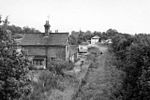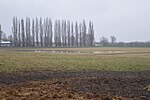The Old Bedford River is an artificial, partial diversion of the waters of the River Great Ouse in the Fens of Cambridgeshire, England. It was named after the fourth Earl of Bedford who contracted with the local Commission of Sewers to drain the Great Level of the Fens beginning in 1630. It provided a steeper and shorter path for the waters of the Great Ouse, and was embanked to prevent them flooding the low ground of the South Fens. Throughout the project, the Earl and his Adventurers faced disruption from those who were opposed to drainage schemes. The project was deemed to have succeeded in draining the fens in 1637, but that decision was reversed in 1638. After a lull during the English Civil War, when much of the work was damaged, the Dutch engineer Cornelius Vermuyden worked with William Russell, the fifth Earl of Bedford to complete the drainage. Disruption and unrest continued while the work was carried out, resulting in the Adventurers employing armed guards. A second river, the New Bedford River, was cut parallel to the first channel, which then became the Old Bedford River. At some point, the Old Bedford River was split into two parts, when the upper section was diverted into the River Delph at Welches Dam, and the lower section was joined to the Counter Drain. Both parts retain the name, but are not connected to each other. The area between the two Bedford rivers acts as a large washland, which holds floodwater when the river channels cannot cope with the volume of water in them.
The river acts as the outlet for a number of land drainage projects. Three internal drainage boards are located along its banks, and there are several pumping stations which pump water from low-lying fens into the Counter Drain and the lower section of the Old Bedford River. At the junction with the Great Ouse is Old Bedford Sluice, through which the water passes to reach the tidal river, but this is not always possible, particularly when high volumes of water are passing down the New Bedford River as a result of heavy rainfall further up the Great Ouse. To resolve this, a pumping station was built at Welches Dam in 1948, to pump water from the Counter Drain and lower Old Bedford River into the River Delph, which runs parallel to the lower river for most of it length, but then crosses the washland to enter the New Bedford River at Welmore Lake Sluice. When pumping occurs, flow in the lower river above Welney is reversed, and a vertical sluice gate prevents water discharged into the river by the Upwell Internal Drainage Board from reaching the pumping station.
The river is navigable from Welches Dam to Old Bedford Sluice, but passage through the sluice can only be made when tidal water levels allow, as there is no lock. Welches Dam Lock used to provide a link from the Middle Level Navigations to the Great Ouse, which was the only link between the two river systems when Well Creek became unnavigable. However, a campaign to save Well Creek from being filled in was successful, and the recommended transfer route follows the old course of the River Nene and Well Creek to Salters Lode Lock at Denver. In 2006, the Environment Agency closed Welches Dam Lock, and despite campaigns for it to be reinstated, it has remained closed. There are proposals as part of the Fens Waterways Link which could result in more of the Old Bedford River becoming navigable, in order to provide a circular cruising route including parts of the Great Ouse and the Middle Level Navigations.










